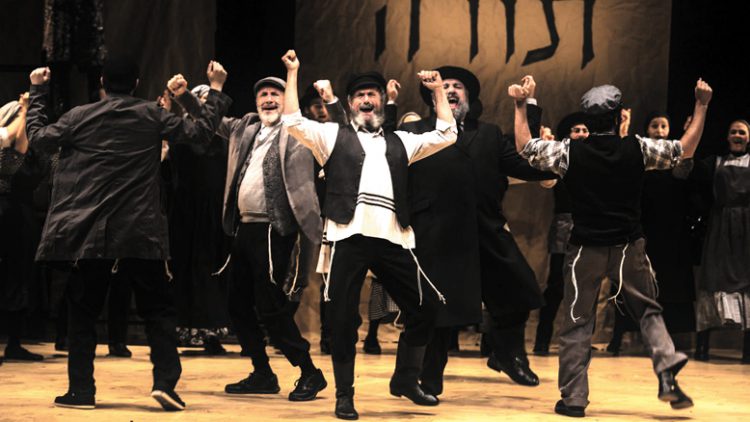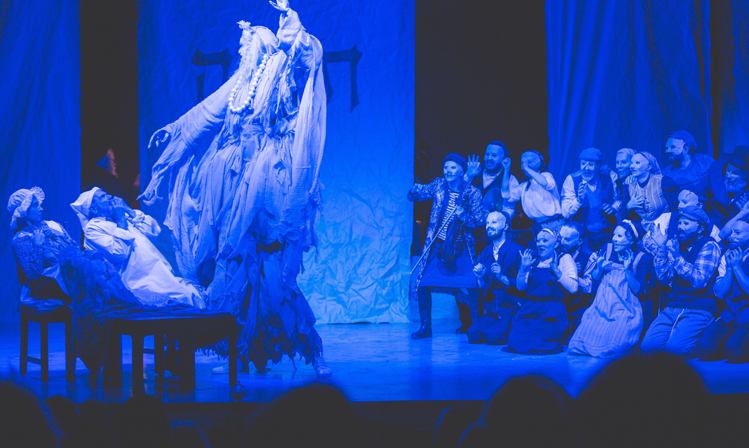Laden with happiness & tears

Folksbiene’s Yiddish Fiddler raises the roof in New York
Theatre Review By Marshall Weiss, The Dayton Jewish Observer
When the National Yiddish Theatre Folksbiene opened its production of Fiddler On The Roof In Yiddish in July, few would have guessed it would be running five months later — and on its way to off-Broadway.
Staged at the Folksbiene’s home, Safra Hall in the Museum of Jewish Heritage — A Living Memorial to the Holocaust in Manhattan’s Battery Park, Fiddler’s producers scheduled its closing for the end of August.
But this surprise hit, directed by Joel Grey, renders the sweet so much sweeter and the bitter so much more bitter: in ways that are genuine not excessive.
Those who love Fiddler will see it with new eyes, hear it with new ears. Those who have seen too many Fiddlers will experience new dimensions and subtleties.
Steven Skybell is a heart-on-the-sleeve Tevye who deeply loves his daughters but sees where things are heading. Jackie Hoffman’s Yenta the Matchmaker is hilarious in understated despondency.
The ensemble numbers are superbly staged with up-front immediacy by Stas Kmiec, based on the original Jerome Robbins choreography.
Minimal props and a set of large parchment remnants direct the audience to concentrate on the power of the story. And the sounds of the language: the language that was nearly extinguished with the Jews of Eastern Europe, crushed between the Soviets and the Nazis. Supertitles in English and Russian run throughout.
What’s remarkable is that Cleveland native Grey — whose father was the celebrated clarinetist and Yiddish comedian Mickey Katz — is the first to admit he neither speaks nor understands Yiddish.
“I never dealt with the Yiddish,” Grey told The Observer about his direction of this Fiddler, minutes before the show’s 100th performance. “I just dealt with the truth, and the actors and the story, and that was what I followed.”

The production is a dream come true for Fiddler’s music director and conductor Zalmen Mlotek, artistic director of the Folksbiene, who has always wanted to stage the show in Yiddish.
This translation of Sheldon Harnick’s lyrics and Joseph Stein’s book into Yiddish was made by Israeli Shraga Friedman for the show’s premiere there in 1965. Friedman was born in Warsaw. He and his family fled the Nazis in 1939.
The brilliance of the original 1964 Fiddler is that Harnick and Stein created a bridge of understanding with audiences unfamiliar with the world of Eastern European Jews. They harnessed the word tradition as its foundation: what does it mean to maintain or to cast off tradition?
When Friedman translated Fiddler into Yiddish — the language of the Jews of Eastern Europe and of humorist Sholem Aleichem’s original Tevye stories — he cast off the word tradition in favor of the word Torah, which brings back the urgency of what appears at stake for Anatevka’s Jews in czarist Russia on the eve of the revolution. Friedman’s translation also reaches back past Fiddler to employ phrases and expressions from the original Tevye stories.
But 94-year-old Harnick urged the Folksbiene’s artistic team to return the word tradition in the songs and much of the book. It’s the Fiddler set, by Beowulf Boritt, that proclaims the word Torah prominently in Hebrew on the main backdrop, the most worn-looking parchment.
In a charming break with tradition, Grey cast Lauren Jeanne Thomas as the fiddler.
“She was the best one who auditioned,” Grey said.
I wondered if he was influenced by Yiddish star Molly Picon in the 1936 Yiddish movie Yidl Mitn Fidl, in which she disguises herself as a boy to play fiddle with a klezmer band. Picon would go on to portray Yente in the 1971 movie version of Fiddler.
“No,” Grey said, “but that’s a good idea. I mean, if we’d have thought about it. But alas, no.”
Another happy surprise for Fiddler fanatics is the inclusion of part of a song Bock and Harnick wrote for the 1971 movie version that didn’t make the final cut. Yiddish Fiddler’s creative team weaves Any Day Now, an anthem to socialism, into the production with brilliance.
One distraction in the show is Ann Hould-Ward’s costume design. The ensemble sports clothes that look all too new and sometimes all too contemporary. Tevye’s family would have been scraping just above shtetl poverty. Even they look hipster chic.
In a curtain speech before the show, Folksbiene Associate Artistic Director Motl Didner — who tutored the cast in Yiddish — said a major label is set to record the production, which runs at the museum through Dec. 30. Fiddler will then open off-Broadway in January at Stage 42, formerly the Little Shubert Theatre.
To read the complete December 2018 Dayton Jewish Observer, click here.

